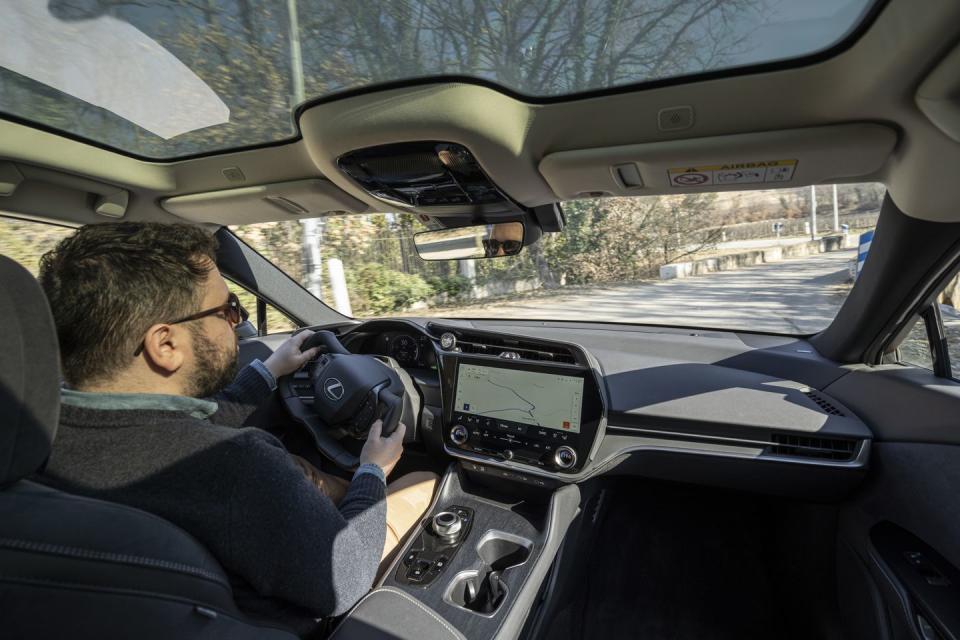How Toyota Is Making the Case for Steer-By-Wire

Toyota is not the first automaker to put steer-by-wire into a production car. Nissan did it with the Infiniti Q50 nearly 10 years ago, but where Toyota’s new system is significantly different is that there’s no shaft connecting the steering wheel to the wheels, just some wiring. The Q50 used a traditional steering system as a backup; Toyota is doing away with it entirely.
It’s a big deal. American customers will get their chance to try Toyota’s steer-by-wire system in the Lexus RZ450e electric crossover, with the option set to become available in the next few years. When driving the new RZ450e in the south of France, we recently had the opportunity to try a steer-by-wire prototype, and learn more about the system from Lexus RZ assistant chief engineer Yushi Higashiyama.
If we look at the system from the tires all the way up to the wheel, it starts out conventionally. Connected to the steering knuckles via tie rods is a rack and pinion gear, just like you get in most road cars today. The pinion gear is actuated by an electric motor, however, which receives signals from wires connected to the steering wheel itself. As there’s no physical connection between the steering wheel and the rack, the steering ratio can be continuously variable, something Toyota and Lexus take advantage of. (We’ve seen variable-ratio steering before, but that’s just where the ratio increases or decreases as you get towards lock. We’ve also seen variable-assist steering before, but that’s just varying the level of power assist dependent on speed.)
In both the BZ4X and the RZ450e, a yoke-type device is used in place of a traditional steering wheel. (Lexus doesn’t call it a yoke, and in fact, there is no specific name for it yet. A spokesperson for Lexus called it, simply, a steering apparatus.) The steering ratio is speed dependent, and at very low speeds, it’s very quick, so the driver never has to shuffle the wheel. At higher speeds, the ratio is much slower, though it never requires much input. There’s less than a full turn lock-to-lock, so the driver never has to go hand over hand.

“One of the primary reasons we wanted to implement steer-by-wire technology in the [RZ450e] is so that the steering system can keep up with the improvement in accelerator response and vehicle movement response,” Yushi Higashiyama tells R&T through an interpreter.
There are other reasons, too. “There’s a tendency to focus on the new system and the new technology only, but what’s actually happening is we’re looking at the total package of the cabin itself, and how that affects the driver and car relationship,” Higashiyama adds. “It wasn’t that we were trying to do something new just to be new, it’s really that we’re trying to take on that extra challenge to prepare ourself for future applications.”
Extra challenge is apt here. The BZ4X and RX450e are otherwise offered with a totally conventional electric power-assist steering system. Toyota sees steer-by-wire as the future, and figured these new electric cars presented a great opportunity to develop the new technology.

We drove a Lexus RZ450e prototype with steer-by-wire in the South of France, and the feel was a little strange. At low speeds, it’s very easy to put in too much steering, as the ratio is far faster than any other car’s, but as you get up to road/highway speeds, the ratio slows and it feels a lot more natural. Still, it’s easy to get thrown off because you’re never quite sure what ratio the car will pick. Hardest is slowing down to a near or complete stop from, say, 50 mph to make a sharp turn, because the ratio change is dramatic and sudden. Once you’ve turned in, however, the ratio doesn’t change until you return back to center, even if you add or reduce speed.
The weighting felt fairly natural for everyday driving, though for spirited driving, it felt odd. If you’re in a long corner, for example, with a fixed steering angle and you add some power, you don’t really get sense of the steering unwinding in your hands as you get closer to the limits of grip. In fact, the weighting doesn’t really change at all. Plus, you always have the sense of a motor on the steering wheel torquing back at you, rather than the motor working with you as in a conventional EPAS system. But, it’s early days for a system like this, and Lexus representatives told us as much. Plus, how much steering feel do you need in a luxury electric crossover? Not that much, all considered. Lexus’ upcoming EV sports car, however, will be a different case.
Toyota and Lexus could in theory do a steer-by-wire car with a conventional wheel and a much slower ratio, too. While the automaker hasn’t said if it will do this, there might be good reason too. There’s the packaging/safety/autonomy benefits we discussed earlier, and there’s also an efficiency gain from getting rid of the power assist system.
Of course, you’re probably wondering about the safety, especially where Toyota doesn’t have a mechanical backup as Nissan does. Here essentially, there’s two of every component in the steering system, so if one fails, there’s a backup. In normal operation, steer-by-wire is powered by the 400-volt battery used to power the traction motors, and if that fails, it can run off the car’s 12-volt system. And if that fails, there’s a small backup lithium-ion battery for the steering system alone.
There’s nothing in the Federal Motor Vehicle Safety Standards that defines minimum performance parameters for steering systems in cars sold in the U.S. Just standards regarding the crash safety of conventional steering systems. That said, the National Highway Traffic Safety Agency (NHTSA) published a study in August 2018 on steer-by-wire systems, their potential failure modes, and fail-safes/backups, seemingly with an eye towards implementing new standards. UN regulations detail all sorts of performance parameters, and Lexus says they'll meet these, plus any additional regional requirements where the system is offered. The brand is confident that the product will be fully safe once it reaches customers in the next few years.
There’s a lot of advantages to steer-by-wire beyond the variability of steering ratio. For starters, it’s a lot easier (cheaper) to engineer left- and right-hand drive versions of the same car. From a safety perspective, there’s no need to make sure that the steering column collapses in the correct way so as not to injure the driver in a crash. Steer-by-wire is also a requirement to achieve full autonomous driving, and the fantasy of a self-driving car with a steering wheel that folds itself into the dash. And from a dynamics perspective, the system offers limitless tuning possibilities.

That last point should be of particular interest to the Road & Track reader. A lot of enthusiasts mistakenly think that electric power-assist steering (EPAS) systems sap the driver of all steering feel. This isn’t quite the case. The electric motor used for power assist naturally dampens a lot of the vibrations coming up through the column, and that information can be further filtered out with the calibration of the motor, but there is still a physical connection. With steer-by-wire, you could, in theory, filter out everything and create a car with no steering feel whatsoever. But on the flipside, that also means you can make the steering feel like whatever you like. “Let’s say you have certain road conditions that jolt the steering wheel, you can eliminate all that,” Higashiyama says. “On slippery surfaces, when you’re losing traction that information is directly put back in.”
Steering feel in a conventional system is determined by geometry and the calibration of a power-assist system, if applicable. With steer-by-wire, the feel is determined entirely by programming, which raises interesting possibilities. The geometry to create a steering system that feels good in a driver’s hands and one that maximizes tire grip are not the same. For example, increasing caster angle can increase cornering grip, but without power assist, it makes steering excessively heavy. In theory, an engineer working with a steer-by-wire system can use all sorts of unexpected geometries that have no effect on what the driver feels in the hands, the system compensating for any odd behaviors happening at the ground. (Something that could be especially useful in racing.) Even beyond that, you could tune a steer-by-wire system to feel just as good as the best manual steering in the world.
It might be a few years before Toyota puts steer-by-wire into production, but the floodgates will soon open. Major German supplier ZF said last year it has “significant volume contracts by multiple major car manufacturers” for its own steer-by-wire system. Other suppliers are working on their own, too. Perhaps it’s too early to say whether steer-by-wire will become the standard. Certainly, though, it’s going to be a large part of our automotive landscape.
You Might Also Like

 Yahoo Autos
Yahoo Autos 